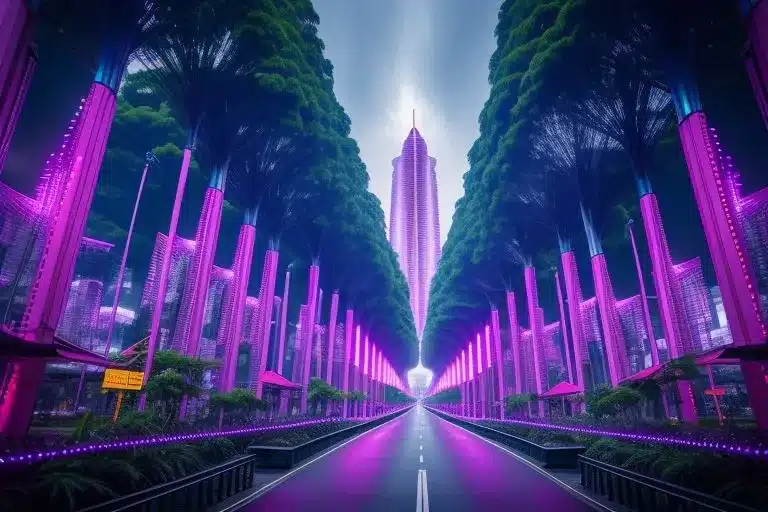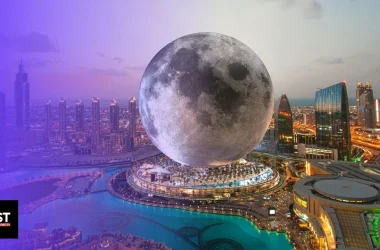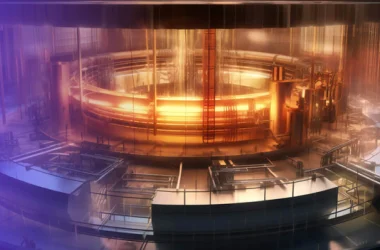Indonesia needs a change.
The capital Jakarta is on the brink. Sinking into the Java Sea, choked by around 11 million residents and beset by dangerous pollution, the capital teeters under the weight of disaster.
But President Joko Widodo has a vision. A vision to build from scratch an entire new capital – four times the size of Jakarta. A futuristic metropolis of the future running on 100% renewable energy.
It’s an undertaking of epic proportions. At an estimated cost of $35 billion, this ambitious infrastructure project seeks to address the existential threats facing Jakarta while positioning Indonesia as a global leader in sustainable development.
And Phase One is already underway. Construction has begun on airports, highways, government buildings and more, with the goal of completion by 2024.
But not all support this bold plan. With stakes so high, doubters question whether Indonesia can pull it off. From financing to the environment to indigenous rights, major challenges stand in the way of realizing the dream.
Meanwhile, the clock is ticking as Jakarta sinks deeper into crisis. Will Nusantara rise to become a shining eco-city, securing Indonesia’s future? Or will it remain a jungle of uncertainty?
The vision for Nusantara
Indonesian government officials have spoken multiple times about the vision for the new capital that is currently under construction. They claim that it will be the first city in Indonesia to run 100% on renewable energy and to achieve net-zero emissions by 2045.
“We want to build a new Indonesia,” The Indonesian President told the New York Times. “This is not physically moving the buildings. We want a new work ethic, new mindset, new green economy.”
The new capital, Nusantara, is four times the size of Jakarta, and it’s being built in the middle of a forest, emphasizing the idea of a green, sustainable, and futuristic city. Government buildings and houses will also be built from scratch, along with other projects.
But unlike some government plans, this project is far from a pipe-dream. Construction began in October and the country is already in the process of building an airport, a hotel, a hospital and a toll-road – all of which are expected to be fully operational by 2024.
The new capital city is already a huge statement to the world, reflecting Indonesia’s vision for the future. But Nusantara is about a lot more than just a fancy new capital, it’s about saving the country’s capital altogether.
The Old Capital
Currently the world’s fourth most populous country, Indonesia reached a population of around 279 million people just this year. However, around 11 million people live in Jakarta, with three times that number in the metropolitan area. This poses a major issue when it comes to the flow of commuters.
Jakarta citizens struggle with extensive traffic on a daily basis, in fact a 2019 study found that the average commuter in Jakarta spends more than 35% of their income on public transport. So the government believes that moving its buildings to a new capital will help reduce the pressure on Jakarta’s streets.
And as you might imagine with a population of this size, Jakarta is also overly-polluted. Its air quality is ranked as one of the worst in the world. With an air quality index of 68 and 630,000 cases of respiratory illnesses recorded in the first half of this year alone.
The seriousness of the pollution issue was demonstrated in 2019, when the Jakarta Advocacy Team filed a civil lawsuit against the government for failing to protect the people’s right to clean air. They won the lawsuit two years later, with the court ruling that the president must take immediate action to improve the air quality in the capital. So it’s possible that the decision to move the capital elsewhere is part of the government’s response to this court ruling.
But given that Jakarta is such a densely populated city, it may come as a surprise that it’s also one of the fastest sinking cities in the world. Although flooding is a natural occurrence in Jakarta due to its swampy lands, 13 rivers, and position against the Java sea, it has gotten much worse over the past few years. Now, climate researchers believe that by 2050, 95% of North Jakarta will be completely submerged underwater.
Some buildings are already being abandoned since almost half the city sits below sea level and is still sinking at an average of 1 to 15 cm a year. As more and more buildings become uninhabitable, it will only aggravate the population issue as well.
Challenges to the move
So given the situation Indonesia finds itself in, it’s clear that moving the capital city is much more than just an aesthetic change. Still there are many challenges facing the move and it won’t be an easy process for any party involved.
The first hurdle to building Nusantara is clearly the cost. The project is expected to cost around $35 billion, making it Indonesia’s most expensive and ambitious infrastructure project ever. The government so far has allocated only $2.6 billion for the city in the 2024 budget plans, but has made it abundantly clear that the Indonesian government will only fund 20% of the project’s total costs.
That 20% will be focused on building main roads, water sanitation infrastructure, the presidential palace and the vice president’s office. So just the essentials, that is if essentials means a palace for whoever dictated the project in the first place.
Joking aside, the plan seems to be to build the essential infrastructure for the first phase and then add on as more funding is unlocked.
The Remaining $28 Billion
The government started construction of the new capital city in 2022, but hopes to lure in foreign investors once the basic infrastructure of the city is completed in 2024. This build it and they will come mentality might not work out as well as Indonesian officials are hoping since there is no assurance that plans for the new capital would still stay in place even if the current administration is replaced.
This uncertainty could be a major deterrent to foreign investors, especially since the next Indonesian general election is in February of 2024, and the opposing party isn’t showing much interest in the new capital plans.
Besides this very big issue, Indonesia is not generally a spender on infrastructure, as illustrated by the country’s infrastructure budget which has been decreasing since it peaked at 2.8% of GDP in 2017. Last year, the infrastructure budget amounted to just 1.9% of GDP.
This raises suspicions over Indonesia’s ability to really commit to and complete a massive infrastructure project like Nusantara. It’s definitely not a vote of confidence that the Jakarta–Bandung high-speed railway, the country’s last major infrastructure project, was completed by China after facing many delays and controversies.
So it’s not really surprising that the project has struggled to secure funds from foreign investors since it was announced in 2019.
SoftBank withdrawal
For a while, it seemed that SoftBank was considering the project and according to a Maritime Affairs and Investment Coordinating Minister it had offered to invest between $30 and 40 billion in the project, although SoftBank itself never publicly mentioned a figure.
SoftBank founder Masayoshi Son was even appointed to the steering committee overseeing the capital city’s construction along with Abu Dhabi Crown Prince Mohammed Bin Zayed and former United Kingdom prime minister Tony Blair. However, it walked away from the project in 2022 for reasons that are still unclear.
Some analysts believe Son’s departure was due to the global economic downturn while others point to Son’s personality and theorize his “unreasonable demands,” such as his insistence that the government plan for a population of 50 million if Nusantara to meet the economies of scale needed to make it “investible”, was just a tactic to get out of the project. But according to Investment Minister Bahlil Lahadalia, SoftBank abandoned the project because Indonesia wanted a fair investment model.
Whatever the case may be, SoftBank’s departure was not a good sign for the project. So far no foreign party–state-backed or private–has entered into a binding contract to fund the project. Some potential investors have signed letters of intent, but there’s no firm commitment to actual spending.
The reason for this reluctance may be because the Indonesian government is only willing to fund 20% of the project while investors have to bear 80%. The new capital is very risky as it’s being built in the middle of a forest, leading investors to believe it’s only fair if the risk was distributed 50-50. However, the Indonesian government is holding fast to its commitment of 20%.
Growing confidence in Nusantara
Despite this, confidence in the project is growing day by day, according to the Nusantara Capital City Authority. Data released by the new capital’s authority showed that there have been 182 letters of intent from investors expressing their interest in the project since October 2022, and 50% of them are foreign investors. Foreign companies from China, South Korea, Singapore and Japan have expressed interest in taking part.
But even if the Indonesian government somehow manages to receive investment on its current terms, problems beyond financing will emerge.
Social and environmental challenges
The Balik Indigenous people, who live on the island of Borneo, fear being displaced by the new construction in their hometowns. Many are struggling to get water because the construction blocked the river, and parts of their lands were taken for the new capital’s development.
Families of indigenous people were given only $3,000 from the government in compensation – a small amount compared to the construction’s impact on their lives. Besides this, they live in constant fear of losing their lands to people coming from the old capital. The government aims to relocate 1.9 million people to Nusantara by 2045, with some moving in as soon as the first phase of construction is completed in 2024.
It’s not just the Balik people that are concerned about the new capital’s progress. Citizens of Jakarta are also worried, as many of them won’t be able to move to the new capital and fear being left behind with Jakarta’s problems.
But the president said that he won’t abandon the country’s financial capital. Jakarta will still be given priority in its development as a financial city and trade center on a regional and global scale. However, it’s not clear if the government will be able to afford the cost of protecting Jakarta from sinking and pollution while it also invests in the new capital.
Nusantara faces other challenges – in particular environmental concerns. Almost as soon as its location was announced, the outcry began and it’s not hard to see why. The island of Borneo is called “The lungs of the world” due to its large trees and forests. It is also home to endangered wildlife such as the orangutan monkeys, leopards and the smallest rhinos on the planet.
Environmentalists fear that building such a huge infrastructure project will contribute to faster deforestation in one of the world’s oldest stretches of forests, leading to the destruction of the natural habitats for many endangered species.
Despite being faced with all these challenges, the Indonesian government hasn’t faltered even once. Enthusiasm for the project has spurred it on as government officials vow to make it an economic hub, attracting renewable energy, healthcare, agriculture, and education business. The president also highlighted the need to increase economic growth in the eastern part of Indonesia, and believes the new capital will become a fintech center for the region.
Elections and global disapproval as hurdles
Overall, Nusantara is definitely an endeavor of truly epic proportions. Not only will it help address the urgent issues facing Jakarta, it aims to establish Indonesia as a global leader in sustainable development and green economics – putting it in the same league as rivals like Singapore and Vietnam. While immense challenges remain, the project definitely reflects where the country sees itself in the future.
However, Nusantara might never be more than glossy photos on brochures.
As mentioned earlier there is no assurance Nusantara will continue if the current administration isn’t re-elected. This is especially worrisome as President Joko Widodo was already elected twice, and according to Indonesian law, he can’t run for president again.
That being said, it’s possible that he will change the constitution to remain in power or continue to delay the General election. Considering the democratic regression under Widodo’s leadership, it seems pretty likely he’ll have a third term.
But it’ll be more difficult for Nusantara to survive a global outcry against the project if more environmentalists attack the so-called “green city” for its impact on endangered species. As you might have guessed, the government can’t really claim to be building a sustainable green city while destroying forests and displacing indigenous people.
The damage to Indonesia’s public image could undo everything the country is trying to achieve with this project and could also impact Indonesia’s growing tourism industry.
But whether it’s a result of Widodo prioritizing his legacy or pressure from the quickly sinking city of Jakarta, Indonesia is wasting no time on naysayers as it races to complete the first phase of construction by 2024
Securing the billions in remaining investment will be difficult, however rising sea levels and pollution will necessitate the move one way or another. As is, the country currently plans to execute the relocation process in five phases through 2045.
If successful, Nusantara would cement President Widodo’s legacy and see Indonesia emerge as a leader in the 21st century green economy. But with 22 years left for relocation and $28 billion in funding left to be found, it remains to be seen whether Nusantara ultimately rises as Indonesia’s first, shining eco-city.
Disclaimer
Please visit and read our disclaimer here.









